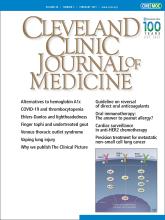Article Figures & Data
Tables
Clinical condition Effect on hemoglobin A1c Mechanism or reason for effect Asplenia Increases hemoglobin A1c Decreased red blood cell (RBC) turnover due to increased RBC life span Chronic kidney disease Effects vary based on severity of underlying disease and therapies Increased hemoglobin A1c
Carbamyl-hemoglobin production in uremic patients Erythropoietin deficiency
Decreased hemoglobin A1c
Shortened RBC survival
Erythropoietin administration
Hemodialysis (lowering of urea levels reduces
carbamyl-hemoglobin concentration)Chronic liver disease Effects vary based on severity of underlying disease and therapies Increased hemoglobin A1c
Jaundice (increased glycation reaction in the presence of higher bilirubin concentrations)
Decreased hemoglobin A1c
Increased RBC turnover
Antiviral drug therapies may decrease RBC life spanHemoglobinopathies Varies with testing method and assay Multifactorial including anemia and rapid RBC turnover Hemolytic anemia Decreases hemoglobin A1c Reduced RBC total volume
Increased RBC destruction shortens RBC life spanIron deficiency anemia Increases hemoglobin A1c Reduced RBC turnover prolongs RBC survival
Greater malondialdehyde concentrations increase hemoglobin glycation reactionsPregnancy Decreases hemoglobin A1c in first 2 trimesters May increase hemoglobin A1c in third trimester Increased RBC turnover decreases hemoglobin A1c
Increased erythropoietin production decreases hemoglobin A1c
Hemodilution decreases hemoglobin A1cTransfusion Variable hemoglobin A1c effects Increased hemoglobin A1c
Elevated glucose concentration in storage medium
Decreased hemoglobin A1c
Dilutional responseVitamin B12 and folate deficiency anemias Increases hemoglobin A1c Reduced RBC turnover prolongs RBC survival ↵a This summation represents most current literature and clinical practice, but should be used as a guide only and should not replace clinical assessment or decision-making.
Based on information in references 1–8.






